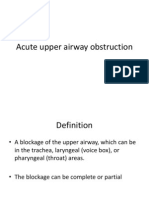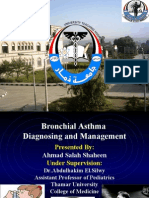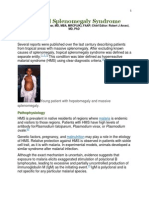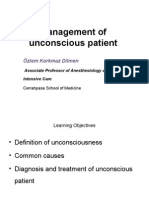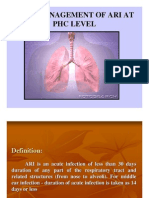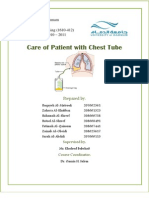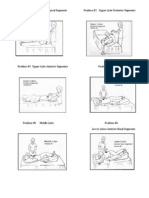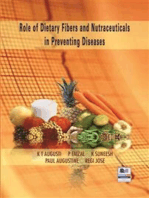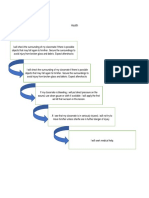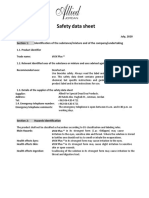100%(2)100% found this document useful (2 votes)
377 viewsASTHMA
ASTHMA
Uploaded by
Ayesigwa Gerald96Asthma is a chronic inflammatory disease of the airways that causes symptoms ranging from mild to severe. It can be triggered by allergens and irritants, which cause inflammation and constriction of the airways. Acute severe asthma, also known as status asthmaticus, is a medical emergency characterized by progressively worsening symptoms despite usual treatments. Its management involves administering oxygen, bronchodilators, steroids, and monitoring for complications such as pneumothorax. Follow up care includes continued steroids, inhalers, and education on precipitating factors and warning signs.
Copyright:
© All Rights Reserved
Available Formats
Download as PPTX, PDF, TXT or read online from Scribd
ASTHMA
ASTHMA
Uploaded by
Ayesigwa Gerald96100%(2)100% found this document useful (2 votes)
377 views16 pagesAsthma is a chronic inflammatory disease of the airways that causes symptoms ranging from mild to severe. It can be triggered by allergens and irritants, which cause inflammation and constriction of the airways. Acute severe asthma, also known as status asthmaticus, is a medical emergency characterized by progressively worsening symptoms despite usual treatments. Its management involves administering oxygen, bronchodilators, steroids, and monitoring for complications such as pneumothorax. Follow up care includes continued steroids, inhalers, and education on precipitating factors and warning signs.
Original Title
ASTHMA ppt
Copyright
© © All Rights Reserved
Available Formats
PPTX, PDF, TXT or read online from Scribd
Share this document
Did you find this document useful?
Is this content inappropriate?
Asthma is a chronic inflammatory disease of the airways that causes symptoms ranging from mild to severe. It can be triggered by allergens and irritants, which cause inflammation and constriction of the airways. Acute severe asthma, also known as status asthmaticus, is a medical emergency characterized by progressively worsening symptoms despite usual treatments. Its management involves administering oxygen, bronchodilators, steroids, and monitoring for complications such as pneumothorax. Follow up care includes continued steroids, inhalers, and education on precipitating factors and warning signs.
Copyright:
© All Rights Reserved
Available Formats
Download as PPTX, PDF, TXT or read online from Scribd
Download as pptx, pdf, or txt
100%(2)100% found this document useful (2 votes)
377 views16 pagesASTHMA
ASTHMA
Uploaded by
Ayesigwa Gerald96Asthma is a chronic inflammatory disease of the airways that causes symptoms ranging from mild to severe. It can be triggered by allergens and irritants, which cause inflammation and constriction of the airways. Acute severe asthma, also known as status asthmaticus, is a medical emergency characterized by progressively worsening symptoms despite usual treatments. Its management involves administering oxygen, bronchodilators, steroids, and monitoring for complications such as pneumothorax. Follow up care includes continued steroids, inhalers, and education on precipitating factors and warning signs.
Copyright:
© All Rights Reserved
Available Formats
Download as PPTX, PDF, TXT or read online from Scribd
Download as pptx, pdf, or txt
You are on page 1of 16
ASTHMA IN CHILDREN
presented by Mbekeka Angella
presented by Mbekeka Angella
Defnition
Asthma is a chronic inflammatory disease of the
airways. Symptoms range from mild to severe,
intermittent to chronic.
Untreated or under treated, asthma can lead to severe
respiratory distress and in rare cases, sudden death.
It can be classified into acute and chronic asthma.
presented by Mbekeka Angella
GENERAL SIGNS AND SYMPTOMS OF
ASTHMA
Wheezing
Chronic or recurrent cough
Tight feeling in the chest
Shortness of breath
Rapid breathing
Nasal flaring
Anxiety
Feeling weak or tired
presented by Mbekeka Angella
Risk factors for developing asthma
A family history of allergy, eczema and asthma
Smoking in the home.
House dust and dust mites.
Premature Births < 36 weeks of gestation.
Presence of Pets in families
presented by Mbekeka Angella
Triggers:
Allergic- such as dust mites
Non-allergic- such as exercise, viral infections, smoke or
other irritants.
These triggers cause inflammation and afterwards,
tightening of the airway muscles.
Only those with allergic asthma have symptoms triggered
by allergens such as pet dander, pollen and dust mites.
About 80- 90 % of adults with asthma have allergic
triggers.
presented by Mbekeka Angella
Cont
The body attempts to expel the allergen/s by releasing
several chemicals including histamines, causing
sneezing, runny noses, watery eyes and broncho-
constriction.
Histamines cause bronchial smooth muscles to
contract which in turn, makes exhaling more difficult.
In a child with asthma, histamine can also trigger
asthma symptoms.
presented by Mbekeka Angella
Pathophysiology
Incase of a trigger factor for example allergens the
body tries to produce chemical histamine which brings
about a running nose, watery eyes and Broncho
constriction. These histamines in excess cause smooth
muscles of the bronchus to constrict making exhaling
very difficult bringing about a difficult in breathing,
wheezing etc.
There excess histamine release in the body tend to
exacerbate asthma attacks.
presented by Mbekeka Angella
Acute severe asthma. (STATUS
ASTHMATICUS)
Clinical diagnosis is defined by increasingly severe
asthma not responsive to drugs that are usually
effective.
presented by Mbekeka Angella
Features of acute severe asthma
Cyanosis or SaO2<92%.
Severe chest retractions and use of accessory muscles.
Inability to talk in an older child.
Silent chest on auscultation (minimal air exchange).
Pulsus paradoxicus >20mmHg (the difference in
systolic arterial blood pressure in inspiration and
expiration doesn’t normally exceed 10mmHg).
Lethargy or changes in mental status.
Hypercapnia (CO2 retention-PaCO2
>50mmHg/>7kpa.
presented by Mbekeka Angella
Management
Before specific therapy the patient must be given high
flow oxygen.
Subcutaneous adrenaline 0.01ml/kg/dose (max 0.3ml)
can be repeated twice, 20min apart.
Nebulised salbutamol or albuterol given every 3hrs.
IV hydrocortisone 6mg/kg/dose 6hrly for 24hrs.
presented by Mbekeka Angella
Management -cont
IV aminophyline 6mg/kg as a loading dose and then
5mg/kg/dose every 6hrs or 1mg/kg/hr. watch out for
signs of toxicity like tachycardia, vomiting,
arrhythmias.
Prednisolone orally 1-2mg/kg/day for 5 days.
No sedation should be given even if the child is
restless.
presented by Mbekeka Angella
Supportive therapy
Give oxygen at a concentration of 100%. Remember
all children with severe asthma are hypoxic. The SaO2
should be >95%.
Maintain hydration by IV fluids or NGT.
Antipyretics should be given if the child is febrile.
Antibiotic should be considered if particularly the
child has a high temperature or localizing signs on
CXR.
presented by Mbekeka Angella
Investigations
FBC
Oxygen saturation, capillary or arterial blood gases..
Blood chemistry- Na, K, Cl, bicarbonate, and glucose.
Chest X-Ray.
presented by Mbekeka Angella
Cautions
If despite the above treatment the child’s condition
does not improve or worsens, then refer immediately
to the intensive care ward for intubation and artificial
ventilation.
Remember that all that wheezes is not only asthma.
Consider other possibilities if it is the first episode and
response is poor.
presented by Mbekeka Angella
Complications
Pneumothorax .
Lung collapse.
Mediastinal empysema.
presented by Mbekeka Angella
Follow up
Continue oral steroids at discharge for a total of 5
days.
Metered dose inhaler of β2 agonists for mild
attacks.
Home nebuliser for moderate asthma attacks.
Inhaled steroids or sodium chromoglycate if the
child has recurrent admissions for severe asthma.
Counselling of the child about precipitating factors
(e.g. pollution, smoking, dust), explain drug
management and when they should bring their
child to hospital (e.g. signs of severe distress: baby
not breastfeeding, child unable to talk.)
presented by Mbekeka Angella
You might also like
- ACR Sample OntarioDocument5 pagesACR Sample OntarioAlisha PowerNo ratings yet
- Esophageal AtresiaDocument18 pagesEsophageal AtresiaNeha RathoreNo ratings yet
- Colonoscopy - : A Pictorial OverviewDocument29 pagesColonoscopy - : A Pictorial OverviewshravaniNo ratings yet
- Floppy ChildDocument34 pagesFloppy ChildHassan.shehri100% (3)
- The Tonsils (Waldeyer's Ring) - Lingual - Pharyngeal - Palatine - Tubal - TeachMeAnatomyDocument4 pagesThe Tonsils (Waldeyer's Ring) - Lingual - Pharyngeal - Palatine - Tubal - TeachMeAnatomywachito ricoNo ratings yet
- Bronchiectasis: By: Karunesh KumarDocument21 pagesBronchiectasis: By: Karunesh KumarAnkan DeyNo ratings yet
- BurnsDocument44 pagesBurnsJANARTHANAN VNo ratings yet
- DYSPHAGIA FINALgDocument48 pagesDYSPHAGIA FINALgSurbhi BhartiNo ratings yet
- Acute Upper Airway Obstruction (Power Point)Document21 pagesAcute Upper Airway Obstruction (Power Point)Sawsan Z. Jwaied100% (2)
- Lumbar PunctureDocument27 pagesLumbar PunctureWitneyGrace100% (1)
- Status AsthmaticusDocument15 pagesStatus AsthmaticusDaianne Joy DonatoNo ratings yet
- Dr. ChintanDocument24 pagesDr. ChintanamrendraNo ratings yet
- Altered Sensorium and Care of Unconscious PatientsDocument17 pagesAltered Sensorium and Care of Unconscious PatientsChhabilal BastolaNo ratings yet
- Infective EndocarditisDocument12 pagesInfective EndocarditisPriyanjali SainiNo ratings yet
- Chest PhysiotherapyDocument4 pagesChest Physiotherapyhakky gamyNo ratings yet
- Ears, Nose and Throat Diseases: Prepared By: Hannelli BelingonDocument103 pagesEars, Nose and Throat Diseases: Prepared By: Hannelli BelingonPatricia Kamille I. PawidNo ratings yet
- Cyanotic Congenital Heart DiseaseDocument6 pagesCyanotic Congenital Heart DiseaseSimran JosanNo ratings yet
- Bronchial AsthmaDocument29 pagesBronchial AsthmaDrShaheen100% (5)
- TracheostomyDocument31 pagesTracheostomyTonyScaria100% (1)
- Pyloric StenosisDocument14 pagesPyloric Stenosisgangguan hepatobilierNo ratings yet
- Pyloric StenosisDocument2 pagesPyloric Stenosisgeorgeloto12No ratings yet
- Brain Tumor in ChildrenDocument42 pagesBrain Tumor in ChildrenKryztalGhail Llanora75% (4)
- Presentation of Upper GI EndosDocument44 pagesPresentation of Upper GI EndosHaqmal0% (1)
- Hepatic EncephalopathyDocument3 pagesHepatic EncephalopathySuhas KandeNo ratings yet
- Spleen PercussionDocument13 pagesSpleen PercussionRatusweethella Intan Yudagrahania PuspitaNo ratings yet
- Ectopic PregnancyDocument36 pagesEctopic PregnancyLorenz BreezNo ratings yet
- Tropical Splenomegaly SyndromeDocument12 pagesTropical Splenomegaly SyndromeSaidAandySaida100% (1)
- Central Venous CatheterizationDocument16 pagesCentral Venous CatheterizationNavjot Bajwa100% (1)
- Sigmoid Volvulus: Rashid Swed S. (Md4) Mwanyingili John A. (Md3)Document46 pagesSigmoid Volvulus: Rashid Swed S. (Md4) Mwanyingili John A. (Md3)Amani Twaha MsemakweliNo ratings yet
- EpisiotomyDocument18 pagesEpisiotomyAnnapurna Dangeti100% (1)
- Pap Smear - Indications &techniqueDocument23 pagesPap Smear - Indications &techniqueapi-3823785100% (1)
- Hypertrophic Pyloric StenosisDocument23 pagesHypertrophic Pyloric StenosisRahel Imelda PanggabeanNo ratings yet
- Hydrocele: Consultant: Dr. Bernard, Sp.UDocument32 pagesHydrocele: Consultant: Dr. Bernard, Sp.UAmbc Smfk-uaj100% (2)
- Empyema 171013100219Document23 pagesEmpyema 171013100219Mahmoud Abdel MoneimNo ratings yet
- Management of Unconscious PatientDocument51 pagesManagement of Unconscious PatientEmenike Donald Ejieji67% (3)
- Post Term PregnancyDocument14 pagesPost Term PregnancySanthosh.S.UNo ratings yet
- Primary ComplexDocument12 pagesPrimary ComplexLevi PosadasNo ratings yet
- Management of Severe DehydrationDocument64 pagesManagement of Severe DehydrationIgbashioNo ratings yet
- Empyema: By-Komal JaiswalDocument29 pagesEmpyema: By-Komal JaiswalOlga GoryachevaNo ratings yet
- Mas To Pa ThyDocument29 pagesMas To Pa ThyIng YingNo ratings yet
- LSCS PRESENTATIONDocument13 pagesLSCS PRESENTATIONMichael AdkinsNo ratings yet
- Achalasia CardiaDocument27 pagesAchalasia CardiadasdasfNo ratings yet
- BlepharitisDocument4 pagesBlepharitisnan623No ratings yet
- Perinatal Asphyxia - Outline of Pathophysiology and Recent Trends in ManagementDocument31 pagesPerinatal Asphyxia - Outline of Pathophysiology and Recent Trends in Managementokwadha simionNo ratings yet
- Chest PhysiotherapyDocument26 pagesChest PhysiotherapyRence IremedioNo ratings yet
- Case Management of Ari at PHC LevelDocument29 pagesCase Management of Ari at PHC Levelapi-3823785No ratings yet
- Bartholin CystDocument21 pagesBartholin Cystwizborrlyzo006No ratings yet
- Chest Tube Critical SeminarDocument7 pagesChest Tube Critical SeminarRuqia Al-matrouk100% (2)
- Pyothorax / Purulent Pleuritis / Empyema Thoracis: Prepared By: Sharmin SusiwalaDocument22 pagesPyothorax / Purulent Pleuritis / Empyema Thoracis: Prepared By: Sharmin SusiwalaAnkan Dey100% (2)
- Lesson Plan On Croups DiseaseDocument6 pagesLesson Plan On Croups DiseasechinchuNo ratings yet
- Different Position in Postural DrainageDocument3 pagesDifferent Position in Postural DrainageMaan MolinyaweNo ratings yet
- Doxovent M MedicalDocument38 pagesDoxovent M MedicalkurutalaNo ratings yet
- MumpsDocument11 pagesMumpscasandra moranteNo ratings yet
- Lie PresentationDocument31 pagesLie PresentationHema Malini100% (1)
- Pulmonary EmbolismDocument46 pagesPulmonary EmbolismAnusha VergheseNo ratings yet
- Bacterial MeningitisDocument13 pagesBacterial MeningitisJubee FelicianoNo ratings yet
- Renal CancerDocument34 pagesRenal CancerArya100% (1)
- Role of Dietary Fibers and Nutraceuticals in Preventing DiseasesFrom EverandRole of Dietary Fibers and Nutraceuticals in Preventing DiseasesRating: 5 out of 5 stars5/5 (1)
- Ventricular Septal Defect, A Simple Guide To The Condition, Treatment And Related ConditionsFrom EverandVentricular Septal Defect, A Simple Guide To The Condition, Treatment And Related ConditionsNo ratings yet
- Acute Respiratory Distress Syndrome, A Simple Guide To The Condition, Diagnosis, Treatment And Related ConditionsFrom EverandAcute Respiratory Distress Syndrome, A Simple Guide To The Condition, Diagnosis, Treatment And Related ConditionsNo ratings yet
- Clinpharm SGD Bronchial AsthmaDocument9 pagesClinpharm SGD Bronchial AsthmaBea SamonteNo ratings yet
- ANATOMY OF THE RENAL SYSTEM - Ayesigwa GeraldDocument13 pagesANATOMY OF THE RENAL SYSTEM - Ayesigwa GeraldAyesigwa Gerald96No ratings yet
- Murokle Johnson Application, CV and DocumentsDocument11 pagesMurokle Johnson Application, CV and DocumentsAyesigwa Gerald96No ratings yet
- ARTHRITIS-by Ayesigwa GeraldDocument38 pagesARTHRITIS-by Ayesigwa GeraldAyesigwa Gerald96No ratings yet
- Diploma Entrants Admissions List 2018 2019 PDFDocument15 pagesDiploma Entrants Admissions List 2018 2019 PDFAyesigwa Gerald96No ratings yet
- Lion and The JewelDocument11 pagesLion and The JewelTaalay Kay100% (1)
- Diploma Holders Requirements 2015 2016Document18 pagesDiploma Holders Requirements 2015 2016Ayesigwa Gerald96No ratings yet
- Lion and The JewelDocument11 pagesLion and The JewelTaalay Kay100% (1)
- COLLEGE REQUIREMENTS (The Required Diplomas) College of Health Sciences 1.1 Bachelor of Medicine and Bachelor of Surgery (MAM)Document4 pagesCOLLEGE REQUIREMENTS (The Required Diplomas) College of Health Sciences 1.1 Bachelor of Medicine and Bachelor of Surgery (MAM)Ayesigwa Gerald96No ratings yet
- Breathing at Depth Physiologic and Clinical Aspects of Diving While Breathing Compressed Gas.Document26 pagesBreathing at Depth Physiologic and Clinical Aspects of Diving While Breathing Compressed Gas.FebyNo ratings yet
- MSDSS1Document4 pagesMSDSS1PeterWayNo ratings yet
- 01.worksheet-1 U1Document1 page01.worksheet-1 U1Jose Manuel AlcantaraNo ratings yet
- Basic Life Support: Trinity University of Asia - College of Medical TechnologyDocument8 pagesBasic Life Support: Trinity University of Asia - College of Medical Technologyrgng_18803040No ratings yet
- MSDS (16) Foamaxx QS PlusDocument4 pagesMSDS (16) Foamaxx QS PlusKhadar SetiawanNo ratings yet
- Rust-Oleum GHS 16 Section SDSDocument7 pagesRust-Oleum GHS 16 Section SDSGerardo RodriguezNo ratings yet
- MSDS PVC001Document6 pagesMSDS PVC001medo.k016No ratings yet
- Hoja de Seguridad RibbonDocument4 pagesHoja de Seguridad Ribbonayrton carls zamora cardenasNo ratings yet
- Material Safety Data Sheet: Health Hazard InformationDocument2 pagesMaterial Safety Data Sheet: Health Hazard InformationWilkaNo ratings yet
- Health and Safety Protocols For The Philippine Film and Av IndustryDocument66 pagesHealth and Safety Protocols For The Philippine Film and Av IndustryJerome DulinNo ratings yet
- Safety Data Sheet: Turtle Wax, Inc. 2250 W. Pinehurst BLVD., STE 150 Addison, IL 60101Document7 pagesSafety Data Sheet: Turtle Wax, Inc. 2250 W. Pinehurst BLVD., STE 150 Addison, IL 60101jkqeNo ratings yet
- Chest PhysiotherapyDocument29 pagesChest PhysiotherapyHari25885No ratings yet
- Johnmar Abuan Health Activity 1: Ready To Go Situation 1Document10 pagesJohnmar Abuan Health Activity 1: Ready To Go Situation 1Katherine B. AbuanNo ratings yet
- servo-air-v4-en-non_usDocument12 pagesservo-air-v4-en-non_usChromil ChlorideNo ratings yet
- ET-55 MSDS - Heavy Duty Oil & Grease FlusherDocument4 pagesET-55 MSDS - Heavy Duty Oil & Grease FlusherVishnu NNo ratings yet
- NGT Feeding Discussion InotDocument2 pagesNGT Feeding Discussion InotRhenelyn Delos ReyesNo ratings yet
- Anesthesia For Healthy Rabbits - Veterinary Anesthesia Update - VINDocument8 pagesAnesthesia For Healthy Rabbits - Veterinary Anesthesia Update - VINCristian FloreaNo ratings yet
- 02.2 Sample Charting - Abbreviations - Narrative Progress Notes PDFDocument3 pages02.2 Sample Charting - Abbreviations - Narrative Progress Notes PDFÀi ZìjǐNo ratings yet
- Ashrae Healthcare c19 GuidanceDocument54 pagesAshrae Healthcare c19 GuidanceKazuto KawakitaNo ratings yet
- Latihan Soal Kelas Xii Maret 20Document11 pagesLatihan Soal Kelas Xii Maret 20MOCHAMMAD AGUS RIDWANNo ratings yet
- Conversation Between Two Friends About PollutionDocument2 pagesConversation Between Two Friends About Pollution058 PAUL MICHAEL S100% (1)
- Viox 60 SDSDocument7 pagesViox 60 SDSmajed alattalNo ratings yet
- LaryngitisDocument9 pagesLaryngitisjonna casumpangNo ratings yet
- Balancing Prana Vayu and Apana Vayu - SivaSaktiDocument6 pagesBalancing Prana Vayu and Apana Vayu - SivaSaktisugumarjeNo ratings yet
- Group 4 Final Paper Draft STADocument45 pagesGroup 4 Final Paper Draft STABenedict LarocoNo ratings yet
- Pediatrics. Lecture 5. URI 2. Laryngitis - PPT (1997-2003)Document44 pagesPediatrics. Lecture 5. URI 2. Laryngitis - PPT (1997-2003)Erika ZachNo ratings yet
- Volcanic Gases: Group 7Document20 pagesVolcanic Gases: Group 7Joanah Marie Angel EANo ratings yet
- SDRA Peligros Ocultos de Un Diagnóstico Sobrecargado Critical CareDocument5 pagesSDRA Peligros Ocultos de Un Diagnóstico Sobrecargado Critical CarePriscillaBRGNo ratings yet
- SOF Olympiad HUMAN BODY Class 3Document2 pagesSOF Olympiad HUMAN BODY Class 3Aayat BazazNo ratings yet








